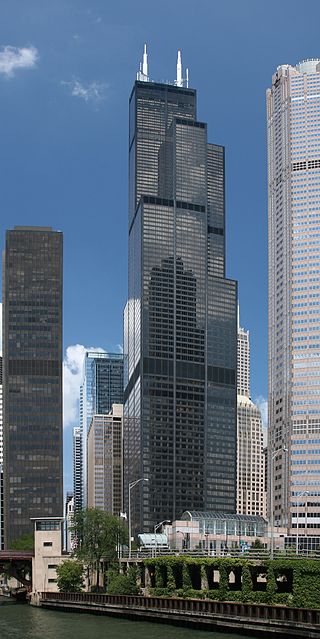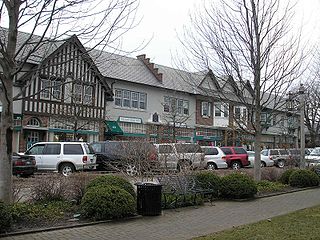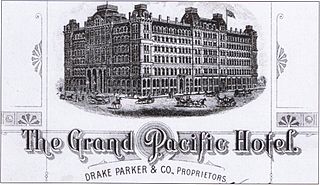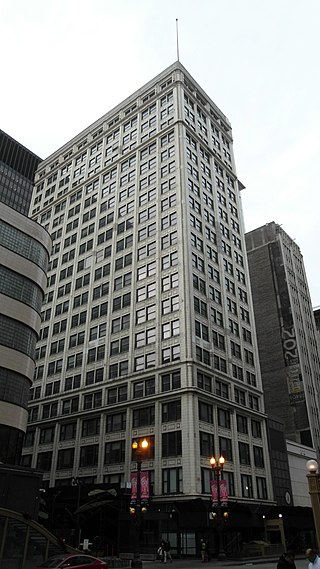
The Home Insurance Building was a skyscraper that stood in Chicago from 1885 to its demolition in 1931. Originally ten stories and 138 ft (42.1 m) tall, it was designed by William Le Baron Jenney in 1884 and completed the next year. Two floors were added in 1891, bringing its now finished height to 180 feet. It was the first tall building to be supported both inside and outside by a fireproof structural steel frame, though it also included reinforced concrete. It is considered the world's first skyscraper.

The buildings and architecture of Chicago reflect the city's history and multicultural heritage, featuring prominent buildings in a variety of styles. Most structures downtown were destroyed by the Great Chicago Fire in 1871.
Marshall Field & Company was an upscale department store in Chicago, Illinois. Founded in the 19th century, it grew to become a large chain before Macy's, Inc acquired it in 2005. Its eponymous founder, Marshall Field, was a pioneering retail magnate.

The Chicago Pedway is a network of tunnels, ground-level concourses and bridges connecting skyscrapers, retail stores, hotels, and train stations throughout the central business district of Chicago, Illinois.

Randolph Street is a street in Chicago. It runs east–west through the Chicago Loop, carrying westbound traffic west from Michigan Avenue across the Chicago River on the Randolph Street Bridge, interchanging with the Kennedy Expressway (I-90/I-94), and continuing west. It serves as the northern boundary of Grant Park and the Chicago Landmark Historic Michigan Boulevard District. Several large theaters, as well as city and state government buildings are on and adjacent to Randolph. Metra's Millennium Station is located under Randolph Street.

The Heritage at Millennium Park, located at 130 N. Garland Court in Chicago, Illinois is a mixed-use tower. Completed in 2005, with a height of 631 feet (192 m) and 57 floors, the building was designed by the architectural firm Solomon Cordwell Buenz. It is the 36th-tallest building in Chicago. Like many newer buildings, the Heritage preserves and makes use of the façades of four existing buildings in its base.

The First Leiter building was a Chicago commercial structure built in 1879 by William Le Baron Jenney. It was renovated and extended in 1888, and demolished in 1972.

The Loop is the 1.79-mile (2.88 km) long circuit of elevated rail that forms the hub of the Chicago "L" system in the United States. As of 2022, the branch served 31,893 passengers every weekday. The Loop is so named because the elevated tracks loop around a rectangle formed by Lake Street, Wabash Avenue (east), Van Buren Street (south), and Wells Street (west). The railway loop has given its name to Chicago's downtown, which is also known as the Loop.

Howard Van Doren Shaw AIA was an architect in Chicago, Illinois. Shaw was a leader in the American Craftsman movement, best exemplified in his 1900 remodel of Second Presbyterian Church in Chicago. He designed Marktown, Clayton Mark's planned worker community in Northwest Indiana.

The Grand Pacific Hotel was one of the first two prominent hotels built in Chicago, Illinois, after the Great Chicago Fire. The hotel, designed by William W. Boyington and managed for more than 20 years by John Drake, was located on the block bounded by Clark Street, LaSalle, Quincy and Jackson. It was a replacement for the Paficic Hotel, which had been built in 1871, only to burn in the fire later that year.

Douglass Park, formerly Douglas Park, is a part of the Chicago Park District on the West Side of Chicago, Illinois. Established in 1869 and initially named South Park, its 173 acres (0.70 km2) are in the North Lawndale community area with an official address of 1401 S. Sacramento Drive.

The Pittsfield Building, is a 38-story skyscraper located at 55 E. Washington Street in the Loop community area of Chicago, Illinois, United States, that was the city's tallest building at the time of its completion. The building was designated as a Chicago Landmark on November 6, 2002.

The Marshall Field and Company Building is a National Historic Landmark retail building on State Street in Chicago, Illinois. Now housing, Macy's State Street, the Beaux-Arts and Commercial style complex was designed by architect Daniel Burnham and built in two stages—north end in 1901–02 and south end in 1905–06. It was the flagship location of the Marshall Field and Company and headquarters Marshall Field's chain of department stores. Since 2006, it is the main Chicago mid-western location of the Macy's department stores. The building is located in the Chicago "Loop" area of the downtown central business district and it takes up the entire city block bounded clockwise from the west by North State Street, East Randolph Street, North Wabash Avenue, and East Washington Street.

19 South LaSalle Street, formerly known as the Central YMCA Association Building, is a building in downtown Chicago, Illinois. It was constructed in 1893 and designed by the architecture firm Jenney & Mundie.

The Sherman House was a hotel in Chicago, Illinois that operated from 1837 until 1973, with four iterations standing at the same site at the northwest corner of Randolph Street and Clark Street. Long one of the city's major hotels, the hotel's fortunes declined in the 1950s amid changes to its surrounding area, and it closed in 1973. The fourth and final building it had occupied was demolished in 1980 to make room for the James R. Thompson Center.

151 North Franklin is a skyscraper located at 151 North Franklin Avenue in the Chicago Loop. Completed in 2018 and standing at 568 feet tall with 35 floors at the northeast corner of West Randolph Street and North Franklin Avenue, the building is the current corporate headquarters of namesake tenant CNA Insurance, which has been headquartered in the Loop since 1900. It also hosts large office spaces for Facebook and the law firm Hinshaw & Culbertson.

Mundie & Jensen was an architectural firm in Chicago, Illinois. Several of its works are listed on the National Register of Historic Places (NRHP).

Alfred Samuel "A. S." Trude was a British-American lawyer. Trude was one of the most noted attorneys in his time, working on a number of high-profile cases. He resided in Chicago most of his life. While he was largely a civil attorney and occasional criminal defense attorney, among his most famous cases as a lawyer was his successful prosecution of Patrick Eugene Prendergast for the assassination of Chicago Mayor Carter Harrison Sr.



















